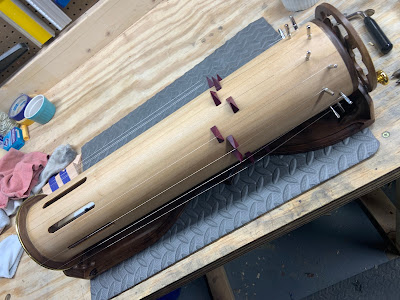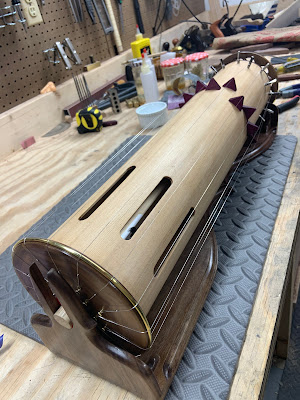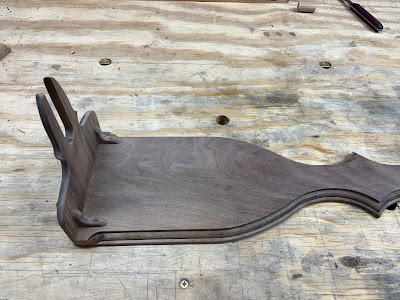This is a deeply personal work and my most ambitious so far. A (perhaps not very) close listen will reveal any number of minor-to-moderate technical flaws, but from a creative and musical perspective, I am very satisfied with it. Certainly, the more than year-long process of bringing it forth has been cathartic. I am especially grateful for my collaborators on the final movement, my daughter Natalie Neale-Lorello, her partner, Johanna Alonso, and their bestie, Nicholas Kosmas, who deserve public acknowledgement for their generous and indispensable contributions.
I feel I should begin by addressing why a confirmed atheist would create a work based on Roman Catholic liturgy. There are a few reasons. First, it was simply an inspiration and I have learned to follow my inspirations. More than that, though, I have in recent years been spending time learning about where I come from, my particular ancestry and my culture generally, and any such investigation for a person of European descent will necessarily be shot through with Christian influence and iconography, whether or not they are Christian by heritage or ethnicity. Because of this deep, generational acculturation, and despite my attitude toward spirituality and religion, a requiem can nonetheless express grief and loss in a way that is meaningful to me; this connection was only enhanced through my training as a classical musician, where I studied requiems both academically and in performance.
Below, I will share some of my ideas and reasons for why I created the work as I did. A brief glance at the track titles will show that I do not follow the liturgy closely. Instead, I have used it as a reference and a source of inspiration. I have taken the Latin prayer titles and themes as frames for exploring related meaning, while pulling directly from it in only a few places – just a single movement bears any close resemblance to its traditional form. Nonetheless, I have throughout attempted to articulate with words, sound, and music some portion of the complex emotions I have experienced in the wake of my father’s death, nearly seven years ago as of this writing.
Anyone who knows my taste in music will recognize the influence in this work of two of my favorite storytellers, Laurie Anderson and Ivor Cutler. I have never been effective as a lyricist or a poet, but I have some confidence in my ability to create a narrative; combine that with my love of timbre and it’s a straight line from there to Anderson’s and Cutler’s prose-over-sound. Additionally, Marcus Fischer’s use of “crinkly” textures in his ambient music inspired me to include such sounds in my own work, for example my use of sleigh bells in the two “Somnia Patris” movements. I feel fortunate that some movements took more melodic forms; although I am not often able to transcribe quickly enough such lines when they occasionally arise in my head, I am grateful that I was able to do so for this project. Put all this together, and you end up with the heterogeneity of styles and structures collected here; nonetheless, I strove for and I hope I was successful in developing enough through-threads to have it all cohere sufficiently.
A note about the general themes in the prayers of the traditional Latin text. Nearly all of a requiem’s prayers are acknowledgments of God’s omnipotence, self-effacement, and pleas for mercy. As an existentialist, I find such appeals generally disempowering, so, instead,I have slotted my own stories into the cubbyholes created by prayer titles and themes; one exception to this is the Pie Jesu, which I felt conveys the kind of weeping, oppressive grief that came as my father’s absence sunk in. I also do not follow the liturgucal order too closely, for example ending with the Lux Aeterna, which feels to me like a much more meaningful image and wish than the traditional ascent to a literal heaven, the In Paradisum, which I employ earlier and very differently here, too.
*****
Praeludium: Introit/Exit
The Latin “introit” means literally “he comes” and, unsurprisingly, the Introit is typically the first prayer in the requiem mass. However, titling a story “he comes” in which my father departs made no sense to me (the irony would have been misplaced), so I looked up “he goes” in Latin and, much to my surprise and delight, it translates as “exit.” That title felt right to me: an introduction in which the hero leaves. I left it unnumbered and named it Praeludium to distinguish it from what I feel is the body of the requiem, all the following movements expressing the aftermath of his death.
This movement is about the immediate experience of my father’s death. As such, it makes sense to me to begin with that precipitating event and to express the sense of momentousness that it engendered. There is no music here; this is not only to set the prelude apart, but also to emphasize the feeling of awkward horror I experienced in those hours listening to my father’s bloodcurdling literal last breaths. I was unable to recreate the sound exactly – despite many experiments both acoustically and digitally – but what I ended up with has the right effect.
I. Kyrie: Simple Mercies
In the traditional liturgy, the kyrie follows the introit; here, it is the first music and the first numbered movement. It is the only one in which I use unaltered standard text. If the Praeludium is the door one walks through to get to the space of the Requiem, this is the first experience of that space on the other side.
I think the kyrie was the first requiem prayer that I learned of as such. I remember studying examples of Gregorian kyries in music history class and being transported by them. The prayer itself resonates with me – a wish for peace, for kindness, for a relief from the inherent injustice of the world, it reminds me of a lovingkindness meditation – and I love its simplicity.
Kyries traditionally feature lengthy melismas (what a modern musician might call riffs) on the last "e" of "kyrie" and the first “e” syllable of “eleison” in each verse. My melodies here are very simple, to my mind not even warranting the label melisma, but they felt right to me; thus the subtitle “simple” mercies.
II. Somnia Patris I: A Family Drive
The texts of both this movement and Somnia Patris II are based on transcriptions of actual dreams I had in the year following Dad’s death. There is no Somnia Patris prayer in the traditional liturgy, but I wanted to include both of these dreams and so made up my own quasi-liturgical title. The Latin here translates to “Dreams of Father”; I had initially intended to use “Dreams of My Father,” but “Somnia Patris Mei” didn’t have the right ring to it.
A technical note. The two Somnia Patris movements here and another standalone piece I created back in 2013 use a vocoder effect I created to sound like a crowd whispering everything I say in the background. From a sound design perspective, if one has any experience with vocoders, it’s fairly simple to make: the vocoder’s sidechain input is, of course, the spoken voice, but the carrier wave is just white noise, with a little reverb added next in the processing chain. I love this effect and was very pleased when I first created and used it in ‘13. Although my actual dream narrations do not sound like this, it somehow conveys the surreality of my dream experience.
III: Tractus: For Those Who Fought For It
The traditional text of the tractus is a plea for absolution. Although my father never talked about his experiences in the Vietnam war in any detail, he did share with me a few times his strong ambivalence about them. From my earliest memories until his death, he often emphasized the importance of recognizing and remembering that, as citizens of the United States, we are born into wealth and privilege that, despite their transparency to us, are far from universal. Although he never spoke it, I often sensed that he felt shame and horror for having bombed the inhabitants of, in his eyes, a far poorer and less privileged nation. Many of his philanthropic efforts over his life had, to me, a sheen of seeking absolution.
IV: Pie Jesu: Cantus
I will admit that the fact that this prayer is featured in a famous skit in “Monty Python and the Holy Grail” influenced my considering including it here. That said, what made the decision for me was the wonderful rhythm that I discovered in the text, which then inspired the hand percussion. My modification of the original text arose from the synergy among these parts. Primarily, however, this movement helped me to express the sense of profound loss I experienced as I came into the reality that I would never again be able to speak with or hug my father.
V: Dies Irae: Anger at Your Passing
The traditional text for the Dies Irae is very long, detailing the events of Judgement Day (the titular “day of wrath”). There is also an extremely famous musical motif from a Gregorian setting of the prayer which I had no intention of including here. Instead, this pseudo-poem came upon me late one night and later I thought to place it under this title. My “days of wrath” were those during which I discovered things about my father, unknown to me during his life, that changed my view of him and, initially, left me judging him harshly.
VI: Somina Patris II: Sleepover
This second of the two dreams of my father was important to include because it operates on many levels. Indeed, in my journal I call it a “metadream,” as it refers to itself, just as Dad refers to himself, with neither reference being explicit, even as they are obvious. Too, like the first dream, it is accompanied by an overwhelming sense of love for him and grief at his absence.
VII: In Paradisum: The Weighing of the Heart
The text for this movement is based on a passage in Tom Robbins’ “Jitterbug Perfume,” a favorite book from my twenties. That passage is itself based on ancient Egyptian beliefs about the afterlife and, in turn, my take on both of these is influenced by Buddhist ideas of the Bardo. It belongs here because I experienced my father throughout his life as striving ever to lighten his heart. Beyond the war, he suffered many deep wounds and challenges, although he was too modest to describe them as such and underplayed their cost to him and his success in addressing them. I have often imagined him at the scales and pictured him either passing or being sent back and, in either case, accepting his fate with his stubborn optimism and gentle grace.
“Erleichda!” is a word that Robbins made up ostensibly from his main character’s 10th century Germanic dialect, translating roughly to “lighten up!” which, again, is an apt term for how my father engaged in life, especially in his later years.
One of the challenges for this movement was that the atmosphere I was after could easily come across as dreamlike, but the narrative is not a dream nor did I wish it to be mistaken for one, so I eschewed the whisper-vocoder used in the Somnia Patris movements. Instead, I strove for a sense of otherworldly space, digitally bending the sounds of live bells and reversing other percussive tones. The vocal effect is a reverse reverb, anticipating the vowels that normally resonate after.
VIII: Sanctus: Not Only Stardust
This movement represents as close to a personal spiritual cosmology as I get; indeed, it is intended as a description of part of how I understand death. It is unique in the work in that it is the only narrative that uses second person; I visualize it as me standing at a podium presenting as a lecture, with an immense screen behind me on which is projected all manner of atomic and cosmological images, protons, electrons, hydrogen atoms, water molecules, all the way up to galaxies and the Cosmic Microwave Background. It is meant as an introduction to the last movement, utilizing many of the same instruments and some of its motifs and finally transitioning to the Lux Aeterna with an attacca.
I admit to taking significant creative license with the central assertion of this narrative, that the hydrogen in our bodies was created in the Big Bang (although, to be fair, I got the idea originally from a Hank Green video). To explain: while protons and electrons were created fractions of a second after the Big Bang, the Universe did not cool down enough for electrons to begin orbiting protons, and thus form hydrogen atoms, for tens or hundreds of thousands of years, depending on what you want to count [Wikipedia].) Additionally, a particle physicist will point out that subatomic particles like protons and electrons aren’t solid objects, but dynamic packets of energy, or wave functions, so to describe them as unaltered is a mischaracterization: they persist, yet they change. Ultimately, I just like the idea of being made of things that have been around that long, which is more or less true.
IX: Lux Aeterna: Eternal Light
Probably unsurprisingly, I spent more time working on this than any other movement. And not accidentally: writing a lux aeterna was what solidified for me the idea to write a full requiem.
Ligeti’s “Lux Aeterna,” featured in “2001: A Space Odyssey,” is one of my all-time favorite musical works. Mysterious, other-worldly, and disturbingly beautiful, I hear snippets of it in my head often. Almost 15 years ago, I took a deep dive into the work, attempting – and failing – to adapt the score for electronic music. This led me to explore the text closely and I learned that, while like most of the rest of the traditional prayers it is a plea for clemency, its image of eternal light is uniquely compelling to me and is most closely aligned with my personal cosmology (notwithstanding our current understanding that the Universe will end in a lightless heat death).
Additionally, its references to the dead being in the company of saints has egalitarian overtones, which also appeals to me. The two English lines in my text,
“May eternal light shine upon him, as all sacred beings.
May he rest eternally in the perpetual light of the blessed.”
reference this and are (very) loose translations of the traditional Latin, more literally translated here as,
“...with Thy Saints for evermore:
for Thou art gracious.
Eternal rest give to them, O Lord,
and let perpetual light shine upon them:
With Thy Saints for evermore,
for Thou art gracious.” [Wikipedia]
*****
To the degree that a prayer is a wish, I embrace the wish that my father be at peace. As an atheist, I believe that he is neither peaceful nor restless, but instead that he is simply not; thus, my prayers have no purpose for him. Prayers for the dead are ultimately not for the dead but for the living and a wish for the dead to rest in peace is a wish for them not to trouble us. I cannot think of my father without being troubled, aggrieved for his absence, but neither would I give up my thoughts and memories of him in order to be rid of those troubles. So the nearest solution is simply to wish to live peacefully in this world which lacks my father – and so I do.
This work is that wish.


































